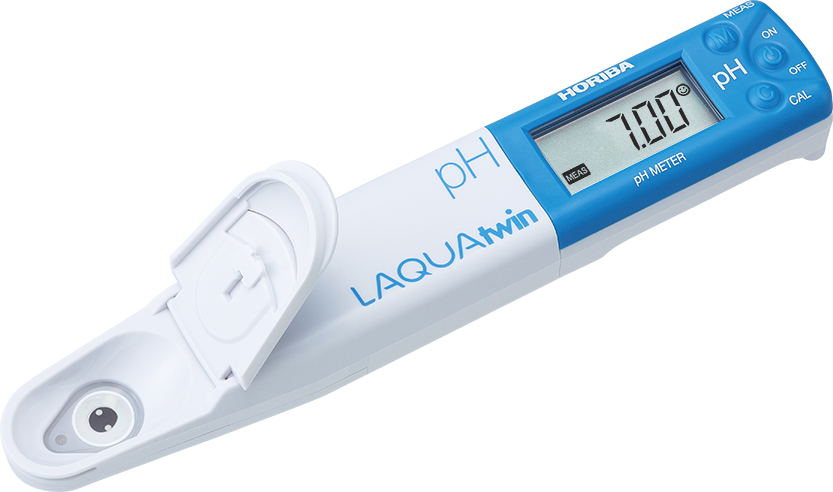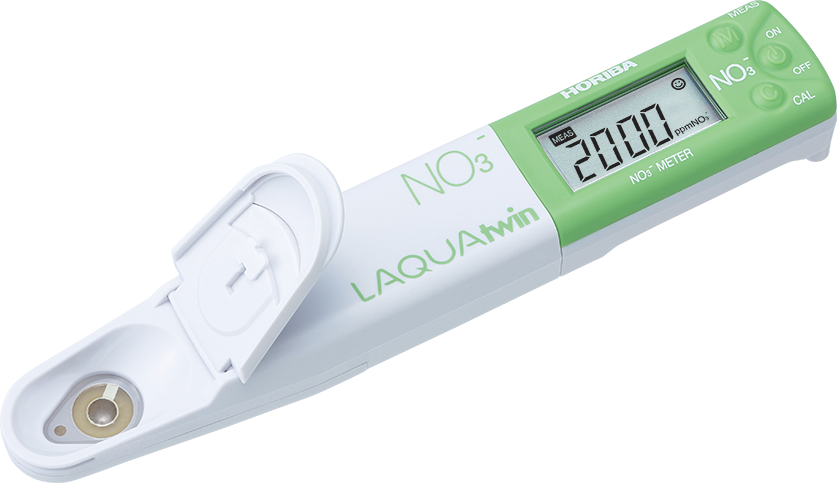Monitoring the water quality in your aquarium with the Pocket Testers from HORIBA
Correctly assess water quality in the aquarium
Experienced aquarists know how important water quality is in the aquarium and determine the relevant parameters using various tests. Regular examination and analysis of the present situation, regardless of the external appearance of the aquarium, improves the well-being and ultimately also the breeding behaviour of the aquarium inhabitants.
Testing aquarium water, such as fresh and salt water (either natural or artificial seawater) with reliable instruments is necessary to provide a clean and safe environment for your aquatic species. The LAQUAtwin pocket meters, are easy to handle, require only a few drops of water and provide the measurement results in a few seconds.
Which values are particularly important for an aquarium?
The most important water values are summarised below:
- The total hardness (GH)
- Carbonate hardness (KH) or acid binding capacity
- The pH value
- The carbon dioxide value (CO2)
- The chloride content (Cl2)
The most important values, the concentration of which should always be checked about once a week, are nitrite, nitrate, the pH value and the water hardness (total hardness and carbonate hardness). In addition, the values for ammonium, chlorine and copper can be relevant for keeping animals in aquarium water. For a good plant population in the aquarium, water values such as carbon dioxide, iron, magnesium and phosphate should be monitored.
The pH value
In the field of aquaristics, the pH value should be between 5.0 and 8.5. Values above or below this scale represent rather extremes that are rarely or never used in aquaristics. A pH value of 7 is considered neutral, whereas values below this are acidic and values above 7 are alkaline. Acidic, or soft water, is often used in the maintenance of blackwater aquariums, but also for South American perches and tetras, as well as for shrimps of the genus Caridina. Alkaline pH values, on the other hand, are more common in hard-water aquariums such as some perches, but also in brackish water and marine fish.
Constant maintenance of a suitable pH value is an important prerequisite for the well-being of the aquarium inhabitants and all aquatic organisms. Sudden and strong fluctuations (when the pH value drops, there is also talk of so-called "pH crashes") should be avoided at all costs. In addition, many substances dissolved in the water are subject to changes depending on the pH value.
For example, the amount of CO2 that can be dissolved in the water is directly related to the pH value.
For this reason, the pH value can serve as a control variable for the adjustment of CO2 fertilisation systems, provided that there are no other acids (e.g. humic acids) in the water that influence the pH value apart from CO2. With pH values between 6.8 and 7.3, a CO2 concentration that is considered harmless for most plants and fish is achieved.
A pH value of 8.2 is considered optimal, especially for marine animals. In particular, lower animals, so-called invertebrates, such as corals, can cause the pH value and also the carbonate hardness to drop through their consumption of calcium bicarbonate if regular replenishment is not provided. In the garden pond, on the other hand, a pH value between 7.5 and 8.5 should be aimed for.
In the case of a CO2 deficiency, algae can quickly consume the hydrogen carbonate available in the water due to their rapid adaptability in the course of their photosynthesis and thus drive the pH value up.
With the HORIBA pH Pocket Tester of the LAQUAtwin series you can easily determine the pH value in your aquarium.
Total hardness (GH) and carbonate hardness - Measurement of calcium
Total hardness and carbonate hardness are the most important parameters for determining water hardness in aquariums. How does the total hardness differ from the carbonate hardness and what influence does it have on fish and plants?
Total hardness is the sum of the positively charged alkaline earth ions dissolved in the water. Calcium, magnesium, barium and strontium are counted as alkaline earths. However, the total hardness is mainly influenced by the content of positively charged calcium and magnesium ions (Ca2+ and Mg2+). For this reason, calcium and magnesium are also called hardness minerals.
Carbonate hardness, on the other hand, is based on the content of negatively charged hydrogen carbonate ions (HCO3-) dissolved in the water.
Since the total hardness, unlike the carbonate hardness, is not influenced by heating or boiling the water, it is also called permanent hardness, while the carbonate hardness is known as temporary hardness.
The unit of total hardness is given in degrees of German hardness (°dH). In addition to its significance for the aquarium biotope, the total hardness is also a decisive quality parameter for drinking water.
What does the total hardness actually mean for the aquarium?
In contrast to the carbonate hardness, the total hardness has no direct influence on the stability or the level of the pH value in the aquarium and also has no direct influence on other water values. Therefore, the total hardness is of less importance to aquarists than the carbonate hardness. However, fish in aquariums need calcium, a so-called hardness former, for example to build bones or bones and to form cell walls. Aquatic plants also need small amounts of calcium. Magnesium is important, among other things, for the function of muscles and nerves in fish. In plant metabolism, magnesium is indispensable for photosynthesis. It should be noted, however, that fish take up a large part of the calcium and magnesium they need through their food.
Calcium, for example, is also an essential element for the health of corals in a marine aquarium. It is used by the corals to form their skeleton, which consists mainly of calcium carbonate. When the calcium level in the water drops below 360 ppm or is depleted, it becomes difficult for the corals to collect calcium for their growth. In this case, calcium chloride (CaCl2) can be added to the water to increase the calcium content.
With the help of the Calcium Ion Hand Tester from HORIBA from the LAQUAtwin series, you can monitor the calcium content, i.e. the hardness former calcium, in your aquarium.
As a rule, soft to medium-hard water in the range of approx. 4 to 14 °dH is well suited for most freshwater fish and aquarium plants.
The total hardness in the aquarium increases, for example, due to the calcium and magnesium contained in the food, if the hardness builders are not sufficiently incorporated into the bones and bones of fish or into the shells of snails. If, for example, the snail population is very high, the total hardness may even decrease over time.
Recommended total hardness values:
- Freshwater aquarium (community tank): 8-25° dGH
- Malawi Lake Tanganyika aquarium: 5-20° dGH
- Planted aquariums with few fish (aquascaping): 3-10° dGH
- Saltwater aquariums: not measurable, as too high. Test calcium and magnesium separately.
- Ponds: 6-20 °dGH
Recommended carbonate hardness values:
- Freshwater aquariums (community tanks): 5-12° dKH
- Malawi-Tanganyika aquarium: 7-20° dKH
- Plant aquariums with few fish (aquascaping): 3-8° dKH
- Saltwater aquariums: 7-10 °dKH
- Ponds: 7-10° dKH
Nitrate (NO3), Nitrite (NO2), Ammonium (NH4) & Ammonia (NH3)
Monitoring the nitrate level is crucial because organic substances such as food and plant residues as well as fish excretions are degraded via the so-called nitrogen cycle. In the process, proteins are converted to ammonium, which in turn is converted to nitrite and finally to harmless nitrate. Various important bacteria are primarily responsible for this. With an appropriate nitrate test, conclusions can therefore be drawn about the health of the aquarium. Medication cures in particular can kill these important bacteria and thus lead to increased ammonium or nitrite levels. In a healthy aquarium, for example, ammonium, which is toxic to fish, is hardly detectable and serves as plant food. Especially in combination with CO2, however, deadly ammonia can be formed, which is why ammonium should always be measured together with CO2. Nitrite is also a strong fish poison that can be very harmful to young animals, invertebrates and especially marine fish. Even the smallest concentrations of 0.5 - 1.0 mg/l can be fatal.
If ammonium and nitrite are elevated, it can be assumed that the aquarium is out of its biological balance and the bacterial balance is irritated. If, on the other hand, the nitrate values remain high and the ammonium or nitrite content low or undetectable, the bacterial balance is intact. However, this is an indication that the balance between fish as nitrogen producers and plants as consumers is not right. Algae in particular start to "explode" if the nitrate content is too high and at the same time there is also a lot of phosphate. Therefore, nitrate levels below 30 mg/l in freshwater aquariums and below 20 mg/l in marine aquariums are considered ideal.
Check the nitrate content in your aquarium with the nitrate hand tester from HORIBA:
Recommended nitrate values:
- Freshwater aquarium (community aquarium): 0-50 mg/l
- Malawi Lake Tanganyika aquarium: 0-50 mg/l
- Plant aquariums with few fish (aquascaping): 10-30 mg/l
- Saltwater aquariums: 0-20 mg/l
- Ponds: 0-10 mg/l
Conductivity (EC)
In addition, the conductivity value in the aquarium is an important indicator of the water quality. In aquaristics, the conductivity is used to control fully desalinated water, brackish water and seawater, as well as to control the salinisation of the aquarium water. Plants consume salts, thus lowering the conductivity, whereas feeding the aquarium inhabitants increases it. To a limited extent, conductivity can also be used as a control value for necessary maintenance measures such as water changes. Everything we put into the aquarium will cause our conductivity to rise. In the aquarium, conductivity values of less than 200 µS/cm are usually not a problem for many soft water fish, but the conductivity value in the aquarium should roughly correspond to the conductivity value of the fish's natural habitat. The conductivity of the water can be determined quickly and easily with a conductivity hand tester from HORIBA from the LAQUAtwin series.
Phosphate - PO4
In general, phosphate is an important plant nutrient and is mostly produced in the aquarium through the excretions of the fish, but also food remains. Too high phosphate levels, however, lead to undesirable algae growth, which occurs especially in heavily stocked waters. Natural and clean waters usually have a concentration of 0.01 mg/l and 0.07 mg/l in seawater. Algae in particular, but also higher aquatic plants, have assimilated to the general scarcity and therefore do not need large occurrences.
Phosphate levels really "explode" in the aquarium if the fish stocking is very high or too many excreta and food remains decay in the aquarium. But phosphate is also often added to drinking water for disinfection and decalcification. Algae in particular then multiply rapidly and are even able to store phosphate and can continue to grow even after a phosphate reduction cure.
Well-planted aquariums, on the other hand, can show the opposite: if plants grow weakly, there may be an underlying phosphate deficiency that should be compensated for with fertiliser.
You can check the phosphate levels in your aquarium quickly and easily using the phosphate test kit from Heyl.
Recommended phosphate values:
- Freshwater aquarium (community aquarium): 0-0.4 mg/l
- Malawi Lake Tanganyika aquarium: 0-0.4 mg/l
- Planted aquarium with few fish (aquascaping): 0.1-1.5 mg/l
- marine aquariums: 0-0.1 mg/l
- Ponds: <0.05 mg/l
TESTOVAL® Colour Comparator: ORTHO-PHOSPHAT - Heyl Neomeris Shop
In our main shop Heyl Neomeris Shop as well as our Pocket Tester Shop you will find a large product portfolio of hand testers as well as colour comparison kits, which enable you to analyse the water quality in your aquarium in an uncomplicated and quick way.






